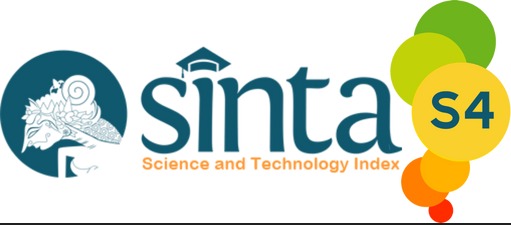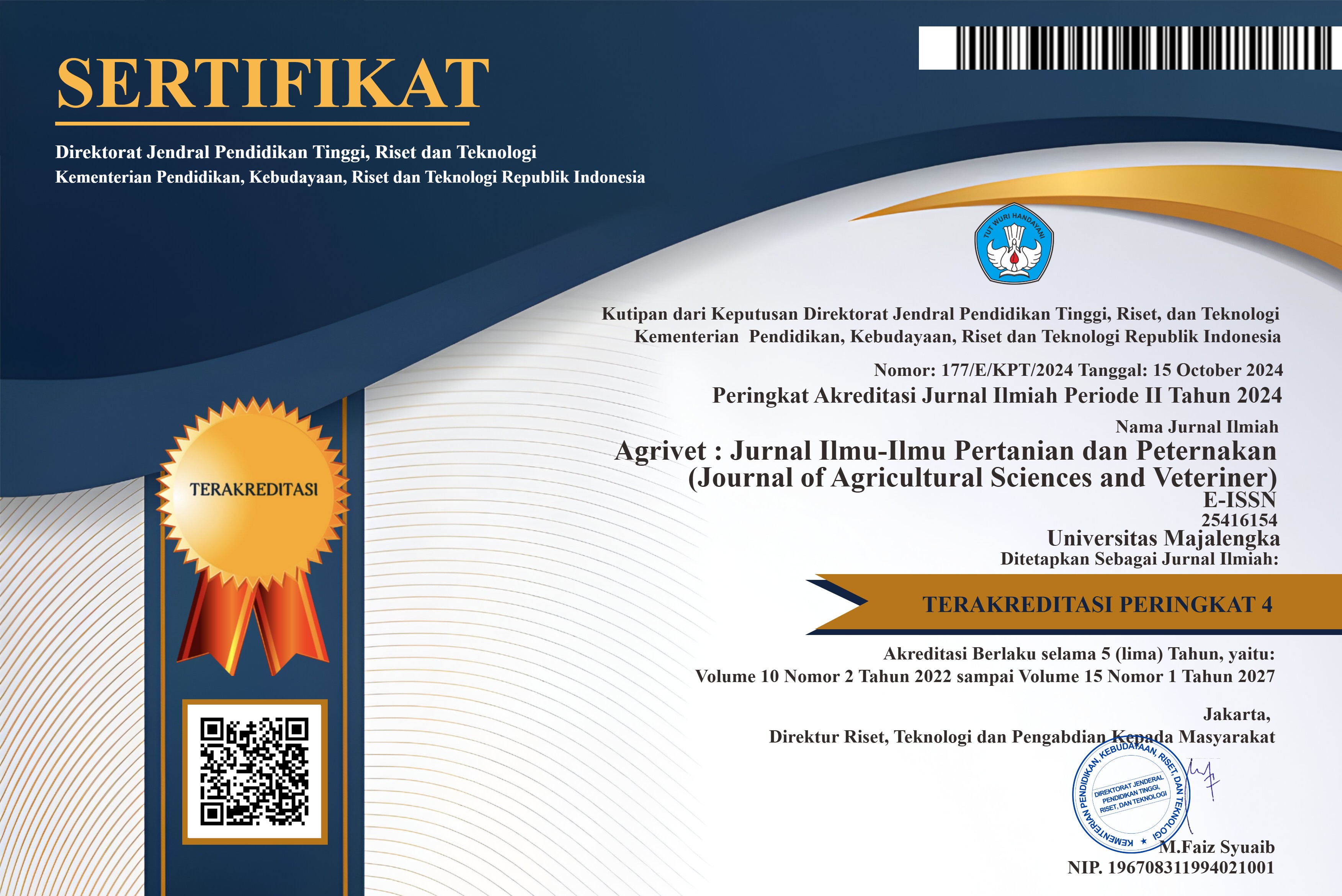Pengaruh penambahan konsentrasi cuka apel berbeda terhadap karakteristik kimia dan organoleptik kaldu ayam petelur afkir
DOI:
https://doi.org/10.31949/agrivet.v11i1.6187Abstract
Laying hen meat is a food ingredient that contains high enough nutrition. The weakness of rejected laying hens is that the meat is very tough, so it is not accepted by most consumers. One way to make chicken meat attractive is to use it as processed broth. Chicken meat and bones contain high levels of minerals and fat, so you need to add apple cider vinegar to remove these substances. This study aims to determine the chemical quality (fat content, ash content, and pH) and organoleptic quality (color, taste, and aroma). This study used 4 treatments, namely P0 (0%), P1 (1%), P2 (2%), and P3 (3%) each repeated 4 times to obtain a total of 16 research samples. The designs used were Completely Randomized Design (CRD) and Randomized Block Design (RAK). The results showed that the average value of chemical quality parameters (fat content, ash content, and pH) along with the addition of the highest concentration of apple cider vinegar was produced by P3 of 3.25%, 0.37%, 5.89. The average organoleptic values (color, taste, and aroma) along with the addition of the highest concentration of apple cider vinegar were produced by P3 of 4.48 in the category of creamy brown color, 4.36 in the category of meaty aroma, and 4.20 in the category of savory taste. It could be concluded that the addition of apple cider vinegar to the culled laying hen broth had a significant effect (P<0.05) on the chemical and organoleptic quality of the culled laying hen broth.
Keywords:
Apple Vinegar, Broth, Chemical, and OrganolepticDownloads
References
Axe, Josh. 2016. Bone Broth Breakthrough. United States of America.
Ayesha, C., Rahman, N.A., Zakiya, Z.T., Handayani, E.S. dan Irdawati. 2021. Proses Fermentasi Vinegar dan Potensinya Sebagai Obat Saluran Pencernaan. Prosiding Seminar Nasional Biologi. 1(2):677–684.
Badan Standardisasi Nasional. 1996. Kaldu Daging. SNI 01-4218-1996. Jakarta: Badan Standardisasi Nasional.
Devidek, J., Velisek, J., and Pokorny, J. 1990. Chemical Changes During Food Processing. Amsterdam: Elsevier Science Ltd.
Hornstein, I. 1971. Chemistry of meat flavor. Agriculture and Food Chemistry. 11(1):147-149.
Kharisma, P. N., Nugroho, N., dan Budirahardjo, R. 2020. Pengaruh Aplikasi Gliserin pada Kekerasan Resin Komposit Nanofiller dengan Perendaman Cuka Apel. e-Journal Pustaka Kesehatan. 8(2):87-92.
Komansilan, S. 2015. Pengaruh Penggunaan Beberapa Jenis Filler Terhadap Sifat Fisik Chicken Nugget Ayam Petelur Afkir. Jurnal Zootek. 35(1): 106-116.
Kurniawan, H., Guntoro, B., dan Wihandyo. 2011. Strategi Pengembangan Ayam Ras Petelur Di Kota Samarinda Kalimantan Timur. Buletin Peternakan. 35(1):57-63.
Lazo, O., Guerrero, L., Alexi, N., Grigorakis, K., Clarel, A., Perez, Z., dan Bou, R. 2017. Sensory Characterization, Physic-chemical properties and somatic yields of five emerging fish spesies. Journal Food research international. 100: 396-406.
Maharani, N., Achmadi, J dan Mukodiningsih, S. 2015. Uji biologis konsumsi pakan, populasi bakteri rumen dan pH pellet complete calf starter pada pedet Friesian Holstein pra sapih. Jurnal Agripet : 15 (1), 61-65.
Maharani, N., J. Achmadi dan S. Mukodiningsih. 2014. Perkembangan mikroba rumen dari hasil uji biologis pellet complete calf starter pada pedet friesian holstein pra sapih. J. Sains dan Matematika. 22 (2) : 36 – 39.
Mamuaja, C. F., dan Helvriana, L. 2017. Karakteristik Pasta Tomat dengan Penambahan Asam Sitrat Selama Penyimpanan. Jurnal Ilmu Dan Teknologi Pangan. 5(1): 17–23.
Musa, A., & Lawal, T. 2013. Proximate composition of ten types of biscuits and their susceptibility to tribolium castaneum herbst (Tenebrionidae: Bostrichidae) in Nigeria. Food Sci Quality Management, 14(1): 33-40.
Nafie, L., Sipahelut, G.M., dan Armadianto, H. 2021. Pengaruh Level Cuka Lontar pada Pembuatan Kaldu Tulang Sapi Coklat (Brown Broth) terhadap Kualitas Fisiko Kimia dan Organoleptik. Jurnal peternakan lahan kering. 3(1):1324-1333.
Ramadhan, H. 2018. Pengaruh Asam Klorida Terhadap Kekuatan Tulang Ayam. Indonesian Journal of Natural Science Education (IJNSE). 1(1):1-6.
Septriansyah, C. 2000. Kajian Proses Pembuatan Gelatin dari Hasil Ikutan Tulang Ayam dalam Kondisi Asam [Skripsi]. Bogor: Institut Pertanian Bogor.
Silab, F.X., Agustinus, R., dan Armadianto, H. 2022. Pengaruh Lama Perebusan terhadap Kualitas Fisikokimia dan Organoleptik Kaldu Putih (White Bone Broth)Tulang Babi yang Menggunakan Cuka Lontar (Borassus flabellifer). Jurnal Peternakan Lahan Kering. 4(1):1952-1959.
Sinaga, I.B, Harahap, L.A., dan Ichwan, N. 2018. Karakteristik Tepung Tulang Yang Dihasilkan Berbagai Bahan Baku Yang Diolah Dengan Alat Penggiling Tulang. Jurnal Rekayasa Pangan dan Keteknikan Pertanian. 5(1):896-900.
Standar Nasional Indonesia [SNI] 01-4273-1996. 1996. Bumbu Rasa Ayam. Jakarta: Badan Standarisasi Nasional.
Steel, dan Torrie. 1993. Prinsip dan Prosedur Statistika Suatu Pendekatan Biometrik. Jakarta: PT. Gramedia Pustaka Utama.
Ton, S., Maharani, N., Widakdo, SWPJ., dan Slamet, R. 2022. Sterilisasi Susu Kambing Dengan Teknologi Ozon Pada Ud Karya Etawa Farm Kelurahan Kalipuro Kecamatan Kalipuro Kabupaten Banyuwangi. Jurnal Pengabdian Kepada Masyarakat : 28 (4), 340-343
Wahid, M.A., Maharani, N., Ton, S., dan Nuraini, U. 2022. Inovasi Mesin Cetak Hidrolik untuk Pembuatan Pakan Ternak Kambing Bulusari’s Farm. Jurnal Madaniya : 3 (4), 999-1005.
Winarno, F. G. 2004. Kimia Pangan dan Gizi. PT Gramedia Pustaka Utama. Jakarta.
Yusuf, D.M., Azwardi., dan Amin, A.M. 2018. Alat Pendeteksi Kadar Keasaman Sari Buah, Soft Drink, dan Susu Cair Menggunakan Sensor PH Berbasis Mikrokontroler Arduino UNO ATMEGA328. Jurnal Teknika. 12 (1): 1–11.
Published
How to Cite
Issue
Section
License
Copyright (c) 2023 Nadia Maharani, Irma Rahayu Ningrum, Muhammad Habbib Khirzin, Dewiarum Sari, Dwi Ahmad Priyadi

This work is licensed under a Creative Commons Attribution-ShareAlike 4.0 International License.
An author who publishes in the Jurnal Agrivet agrees to the following terms:
- Author retains the copyright and grants the journal the right of first publication of the work simultaneously licensed under the Creative Commons Attribution-ShareAlike 4.0 License that allows others to share the work with an acknowledgment of the work's authorship and initial publication in this journal
- The author is able to enter into separate, additional contractual arrangements for the non-exclusive distribution of the journal's published version of the work (e.g., post it to an institutional repository or publish it in a book) with the acknowledgment of its initial publication in this journal.
- The author is permitted and encouraged to post his/her work online (e.g., in institutional repositories or on their website) prior to and during the submission process, as it can lead to productive exchanges, as well as earlier and greater citation of the published work









